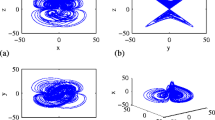Abstract
Considering the dissipative condition, a multi-wing chaotic attractor with a unique perspective is designed, using geometry root locus. By using a nonlinear dissipative term, a new structure is proposed to obtain a dissipative chaotic system with a four-wing attractor. The system properties, namely the phase portraits, bifurcation diagrams, Lyapunov exponents spectrum, Poincare maps and local stability, are investigated by numerical simulations. The phenomenon of multiple attractors is discussed and two double-wing smooth chaotic attractors using two different initial conditions are generated. The nonlinear time-delayed inputs are proposed for chaos control of the new system via bifurcation theory. Based on center manifold and normal form theories, the procedure of determining the direction of the Hopf bifurcation and the stability of the bifurcating periodic solutions are investigated.









Similar content being viewed by others
References
Lorenz EN (1963) Deterministic nonperiodic flow. J Atmos Sci 20:130–141
Chua L (1971) Memristor-the missing circuit element. IEEE Trans Circuit Theory 18:507–519
Chua LE, Komuro M, Matsumoto T (1986) The double scroll family. IEEE Trans Circuits Syst 33:1072–1118
Chua LO, Wu CW, Huang A, Zhong GQ (1993) A universal circuit for studying and generating chaos. I. Routes to chaos. IEEE Trans Circuits Syst I: Fundam Theory Appl 40:732–744
Wang X, Chen G (2012) A chaotic system with only one stable equilibrium. Commun Nonlinear Sci Numer Simul 17:1264–1272
Wei Z, Yang Q (2012) Dynamical analysis of the generalized Sprott C system with only two stable equilibria. Nonlinear Dyn 68:543–554
Wei Z (2012) Delayed feedback on the 3-D chaotic system only with two stable node-foci. Comput Math Appl 63:728–738
Wang X, Chen G (2013) Constructing a chaotic system with any number of equilibria. Nonlinear Dyn 71:429–436
Li C, Sprott JC (2014) Chaotic flows with a single nonquadratic term. Phys Lett A 378:178–183
Wang Z, Cang S, Ochola EO, Sun Y (2012) A hyperchaotic system without equilibrium. Nonlinear Dyn 69:531–537
Esen O, Choudhury AG, Guha P (2016) Bi-Hamiltonian structures of 3D chaotic dynamical systems. Int J Bifurc Chaos 26:1650215
Lai Q, Chen S (2016) Coexisting attractors generated from a new 4D smooth chaotic system. Int. J. Control Autom Syst 14:1124–1131
Lai Q, Chen S (2016) Research on a new 3D autonomous chaotic system with coexisting attractors. Optik 127:3000–3004
Kais B (2015) Gallery of chaotic attractors generated by fractal network. Int J Bifurc Chaos 25:1530002
Chen G, Ueta T (1999) Yet another chaotic attractor. Int J Bifurc Chaos 9:1465–1466
Lü J, Chen G (2002) A new chaotic attractor coined. Int J Bifurc Chaos 12:659–661
Qi G, Chen G, Du S, Chen Z, Yuan Z (2005) Analysis of a new chaotic system. Phys A Stat Mech Appl 352:295–308
Qi G, Chen G, Li S, Zhang Y (2006) Four-wing attractors: from pseudo to real. Int J Bifurc Chaos 16:859–885
Chen Z, Yang Y, Yuan Z (2008) A single three-wing or four-wing chaotic attractor generated from a three-dimensional smooth quadratic autonomous system. Chaos Solitons Fractals 38:1187–1196
Grassi G (2008) Novel four-wing and eight-wing attractors using coupled chaotic Lorenz systems. Chin Phys B 17:3247
Dadras S, Momeni HR (2009) A novel three-dimensional autonomous chaotic system generating two, three and four-scroll attractors. Phys Lett A 373:3637–3642
Lai Q, Guan ZH, Wu Y, Liu F, Zhang DX (2013) Generation of multi-wing chaotic attractors from a Lorenz-like system. Int J Bifurc Chaos 23:1350152
Zhou L, Chen Z, Wang Z, Wang J (2016) On the analysis of local bifurcation and topological horseshoe of a new 4D hyper-chaotic system. Chaos Solitons Fractals 91:148–156
Zarei A (2015) Complex dynamics in a 5-D hyper-chaotic attractor with four-wing, one equilibrium and multiple chaotic attractors. Nonlinear Dyn 81:585–605
Zhou T, Chen G, Yang Q (2004) Constructing a new chaotic system based on the Silnikov criterion. Chaos Solitons Fractals 19:985–993
Wei Z, Sprott JC, Chen H (2015) Elementary quadratic chaotic flows with a single non-hyperbolic equilibrium. Phys Lett A 379:2184–2187
Tian X, Xu R (2016) Stability and Hopf bifurcation of a delayed CohenGrossberg neural network with diffusion. Math Meth Appl Sci 40:293–305
Dong E, Liang Z, Du S, Chen Z (2016) Topological horseshoe analysis on a four-wing chaotic attractor and its FPGA implement. Nonlinear Dyn 83:623–630
Qi G, Wang Z, Guo Y (2012) Generation of an eight-wing chaotic attractor from Qi 3-D four-wing chaotic system. Int J Bifurc Chaos 22:1250287
Guan ZH, Lai Q, Chi M, Cheng XM, Liu F (2014) Analysis of a new three-dimensional system with multiple chaotic attractors. Nonlinear Dyn 75:331–343
Ott E, Grebogi C, Yorke JA (1990) Controlling chaos. Phys Rev Lett 64:1196
Pyragas K (1992) Continuous control of chaos by self-controlling feedback. Phys Lett A 170:421–428
Pyragas K (1995) Control of chaos via extended delay feedback. Phys Lett A 206:323–330
Zarei A, Tavakoli S (2016) Hopf bifurcation analysis and ultimate bound estimation of a new 4-D quadratic autonomous hyper-chaotic system. Appl Math Comput 291:323–339
Tian X, Xu R, Gan Q (2015) Hopf bifurcation analysis of a BAM neural network with multiple time delays and diffusion. Appl Math Comput 266:909–926
Xiao M, Jiang G, Zhao L, Xu W, Wan Y, Fan C, Wang Z (2015) Stability switches and Hopf bifurcations of an isolated population model with delay-dependent parameters. Appl Math Comput 264:99–115
Zang H, Zhang T, Zhang Y (2015) Bifurcation analysis of a mathematical model for genetic regulatory network with time delays. Appl Math Comput 260:204–226
Hassard BD, Kazarinoff ND, Wan YH (1981) Theory and applications of Hopf bifurcation. CUP Arch 129–138
Author information
Authors and Affiliations
Corresponding author
Rights and permissions
About this article
Cite this article
Zarei, A., Tavakoli, S. Design and control of a multi-wing dissipative chaotic system. Int. J. Dynam. Control 6, 140–153 (2018). https://doi.org/10.1007/s40435-017-0309-7
Received:
Revised:
Accepted:
Published:
Issue Date:
DOI: https://doi.org/10.1007/s40435-017-0309-7




